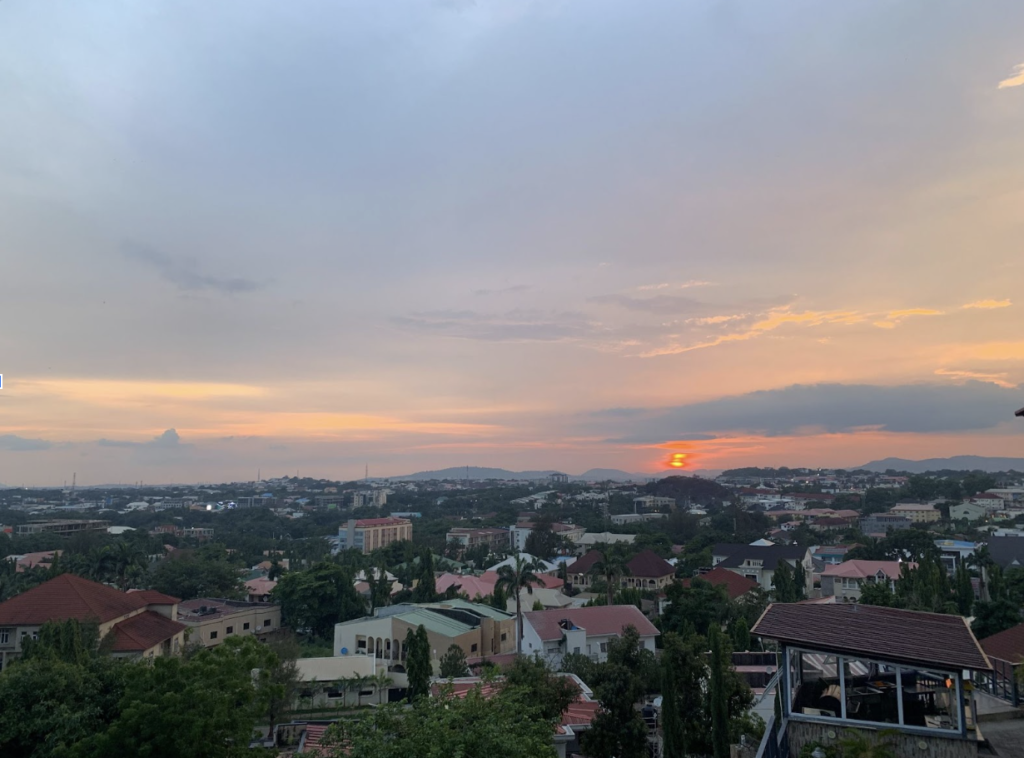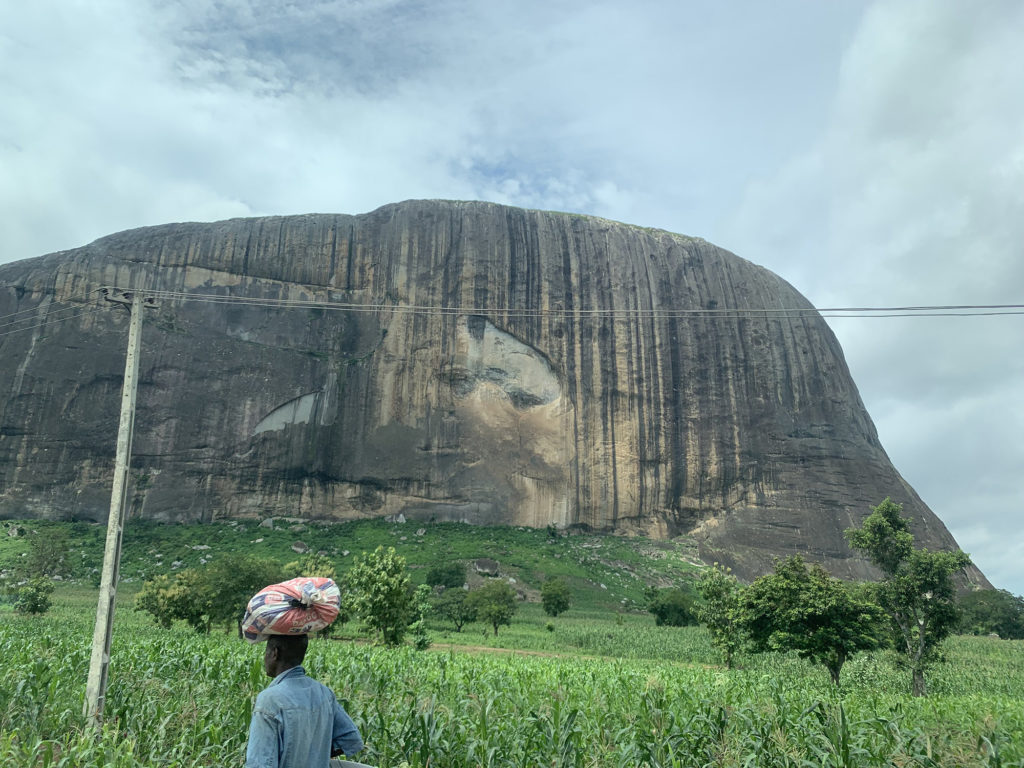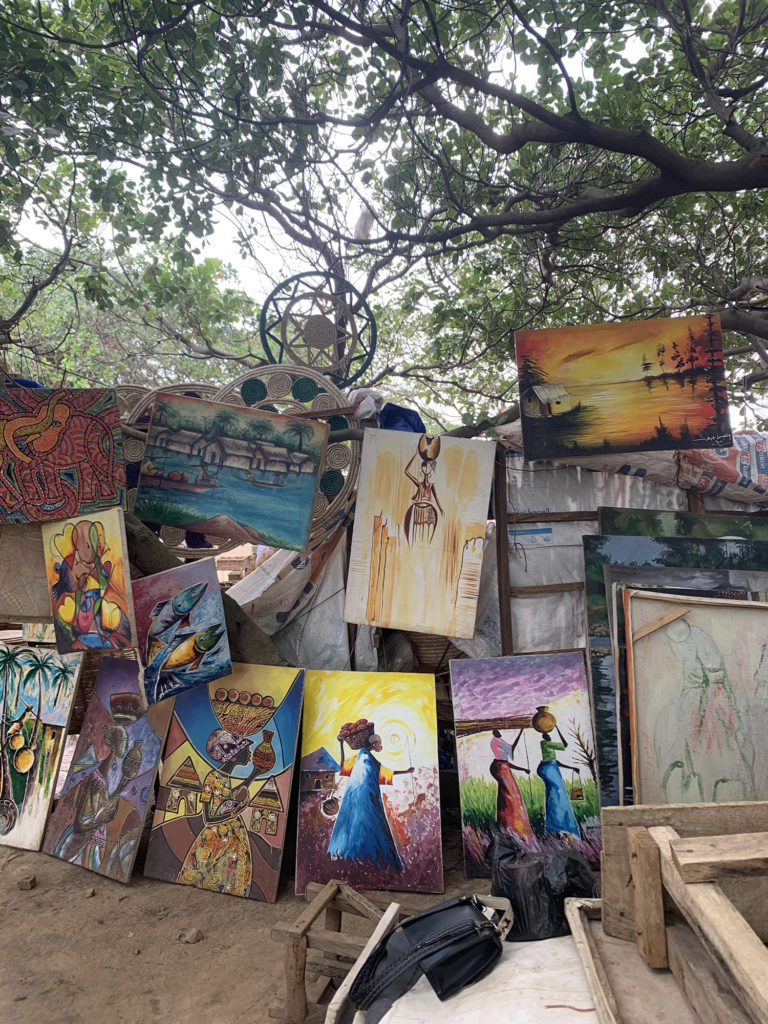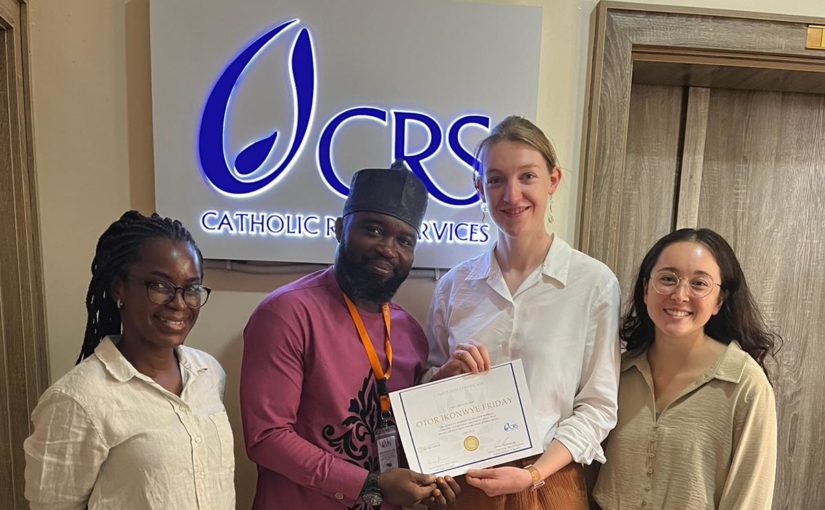Abuja, the capital of Nigeria, swelters in the afternoon sun. It is the rainy season, and yesterday’s morning rains brought gray skies but milder temperatures. Today, however, the air is close and heavy. I feel as though I am inside an elementary school terrarium. The streets are littered with spent bougainvillea petals and a day’s detritus; brilliant Ankara fabrics drape a shop’s windows; neon-scaled lizards dart across the sidewalks. Everything seems oversaturated—I am awed by the color.

Abuja, Nigeria is pink in the setting sun.
I am spending my summer working here with Catholic Relief Services to conduct an evaluation of the Feed the Future Nigeria Livelihoods project, which lasted from 2013 to 2018. The project implemented more than a dozen different activities across six states and impacted upwards of 50,000 people. We have the somewhat rare opportunity to return after completion of the project to ascertain long-term effects as well as the durability of project activities and structures. To that end, we have trained 50 enumerators (data collectors), conducted more than a thousand household surveys, and facilitated more than 70 focus groups and key informant interviews.
Our work is concerned with gauging resilience levels of households in the zone of influence. Resilience-based programming has become in vogue in international development spaces in recent years, especially as climate change spurs incidence of extreme weather, violence, and food insecurity. Although the project did not have a resilience lens when it was implemented, we are looking at it retrospectively with just such a lens, asking beneficiaries if they feel they are better able to weather shocks since the advent of the program. In order to ascertain a household’s true resilience it must be tested under stress, making it tricky to measure, as shocks are just that: unpredictable. Northern Nigeria therefore seems a perfect place to study resilience, as it has experienced livelihood-building interventions, and we know they have faced serious shocks since the project began in 2013, from loss of harvests to the threat of Boko Haram.

Initially, I was excited to work on a resilience project, as agricultural resilience under climate change is the field I hope to go into. However, as time passes and the project becomes more developed, I find my sentiment changing. The Keough School of Global Affairs is founded on the principles of integral human development (IHD), which emphasize the innate dignity of all human beings and urges policies and decisions that consider the most vulnerable. It strikes me that, if we were truly to live the principles of IHD, what we think of as resilience would begin to look very different.
Common institutional definitions of resilience include elements of “mitigate, adapt to and recover from shocks and stressors.” The common thread of these strategies is change—people must change their agricultural practices, their food systems, and even their lifestyles in order to cope with events outside their control. In contrast, early findings from focus groups have participants characterizing their conception of resilience as patience. These two definitions are at odds, with one suggesting dynamic change and the other awaiting return to normalcy. How can resilience interventions be successful when people define it differently?
Furthermore, many of the shocks and stressors faced by these rural and vulnerable communities are symptoms of climate change, which is disproportionately perpetrated by the West. I admit that I too am complicit in this system—just this summer, I will have made 10 trips by plane when it’s all said and done, but my livelihood will not be impacted by any harm done to the environment by such a use of fossil fuels. Resilience-building strategies address a symptom of the problem, but they do not address the underlying problem itself. It strikes me that under a closer adherence to IHD, we would not place the impetus of action on those who are least prepared to endure. Instead, the burden of responding to climate change would fall to those who bear the most blame. It seems particularly unjust given that many of the villages we surveyed had only tenuous access to electricity.

At the same time, one of the greatest lessons I have learned during my fieldwork here in Nigeria is that there are miles between the plan and the execution. When we were planning this project from South Bend, we knew that much would change once we began the work. However, here in the field I truly appreciate the limitations and logistics of a project of this scale. A common refrain in criticism of IHD is the fact that people view IHD as idealistic and not practicable. It is certainly one thing to plan or theorize in the proverbial ivory tower, and fully another to implement a project in the field. While in an ideal world, we would be able to fully realize IHD in our work, given the realities of implementation, it just isn’t practical or even possible.
Both/And
Although my whole team was excited for the opportunity to travel to Nigeria and work with an organization as prestigious as CRS, I was doubly excited to spend time in Nigeria. As an undergraduate, I spent many hours exploring the landscape and psyche of pre-independence Nigeria while writing my thesis on a Nigerian novel: The Famished Road by Ben Okri. Now, as a graduate student, I have come full circle, studying Nigeria in person. Okri’s novel describes the life of Azaro, an Abiku child, a Yoruba concept of the spirit of a child stuck in a cycle of death and rebirth. This hints at the sobering reality of life in rural areas, where so many children died before reaching puberty. Azaro exists in both the spirit world and the real world, teetering on the brink of independence–to borrow from Gabriel García Márquez, an “outsized reality.” Western epistemologies espouse an either/or, binarized reality, one that perpetuates such divisions as Western or white and the “Other”. The work of myriad postcolonial authors around the world reject this notion, and Okri’s work is no exception. The setting that Okri constructs is at once fully Nigerian, but does not ignore the realities of colonization.
The present practice of resilience-building doesn’t seem to truly conform to the principles of IHD. Still, regardless of what steps should be taken, communities are facing shock this very hour. It would be the height of impracticality to ignore the call of the poor in service of some future good. Perhaps in the same way that the literature of Okri and other postcolonial writers exists in this boundary-less both/and space, there is potential for a dialogue around resilience that at once recognizes the necessity and injustice of resilience. In so doing, it would be possible to work to create a reciprocal system, where adaptation efforts on the part of the most vulnerable communities are matched by mitigation practices by the least vulnerable. While it may not be practical to philosophize from afar, removed from the reality of the communities facing these traumas, action divorced from forethought is destined for disaster. It is therefore our work as students and practitioners to marry theory and practice, breaking down harmful binaries, looking at things holistically. In this way, we can ensure that resilience-building initiatives fulfill their intended purpose of granting communities the agency to recover on their own, while recognizing the steps that still must be taken to create a system where they no longer need to.
Top photo: Integration Lab team members congratulate enumerators for completing training in Federal Capital Territory (FCT). From left to right, MGA student Nancy Obonyo, Catholic Relief Services staff member Otor Ikonwye Friday, MGA students Colleen Maher and Emma Hokoda.

